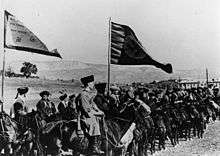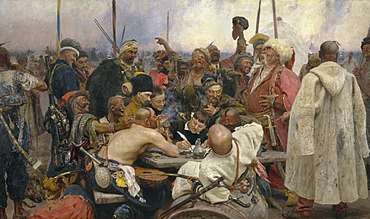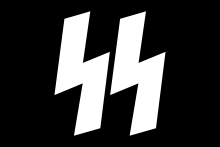XV SS Cossack Cavalry Corps
The XV SS Cossack Cavalry Corps was a cavalry corps in the armed forces of Nazi Germany during World War II.
| XV SS Cossack Cavalry Corps | |
|---|---|
| Generalkommando XV. SS-Kosaken-Kavallerie-Korps | |
 Nazi Cossacks in 1942 | |
| Active | 1 February 1945 – 8 May 1945 |
| Country | |
| Type | Cavalry |
| Size | 25 000—35 000 |
| Commanders | |
| Notable commanders | Helmuth von Pannwitz |
| Part of a series on |
| Cossacks |
|---|
 |
| Cossack hosts |
| Other groups |
| History |
| Cossacks |
| Cossack terms |
Background
In October 1942, the Germans established in the Kuban a semi-autonomous Cossack District and were now in the position to recruit Cossacks from these areas, the POW camps, and defectors from the Red Army. Of the latter, the most significant was the desertion of an entire Red Army regiment (Infantry Regt. 436) that had defected to the Germans in August 1941. Its commander, Major Ivan Kononov, was a Don Cossack. He went on to serve under the Germans.
History
In the summer of 1944 Heinrich Himmler and the SS became interested in gaining control of the 1st Cossack Division under Helmuth von Pannwitz. In July 1944 Himmler discussed the organization of a Cossack fighting unit in the Bialystok region and requested from Hitler, that the Cossack Division would be placed in the organizational structure of the SS. On 26 August 1944 he met with Pannwitz and his Chief of Staff. Himmler planned to gather all Cossack units to form a second Cossack division and proposed the transfer of the 1st Cossack division to the SS. All units were to be placed under von Pannwitz's command. Pannwitz agreed to place his division under SS administration. Both German cadre and Cossack troops would retain their traditional uniforms and their Wehrmacht or Cossack rank. Pannwitz hoped to raise his unit's low morale and to receive more supplies and better equipment.[1]
In November 1944 the 1st Cossack Division was taken over by the Waffen-SS. The SS Führungshauptamt reorganized the division and used further Cossack combat units from the army and the Ordnungspolizei to form a 2nd Cossack Division. Both divisions were placed under the command of the XV SS Cossack Cavalry Corps on 1 February 1945. With the transfer of the Volunteer Cossack-Stamm-Regiment 5 from the Freiwilligen-Stamm-Division on the same day the takeover of the Cossack units by the Waffen-SS was complete.[2][3] According to Samuel J. Newland, the Corps, composed of the 1st and 2nd Cavalry Brigades and the 1st and 2nd Division, was actually formed on 25 February 1945, when it was officially created by the High Command.[4] The Corps was initially subordinated to the Army Group F in Croatia, and since March 1945 to the Army Group E in Croatia.[5]
The Corps supported the German offensive Operation Spring Awakening in Hungary by launching an offensive against a Soviet bridgehead at Valpovo on the Drava. During April the Corps was engaged in minor actions and then began to withdraw from Yugoslavia on 3 May 1945. The superior officers had concluded that the Corps should fight their way back to Austria in order to be captured by the British. According to one source Pannwitz felt that the West would have great use for the Corps as a military anti-Bolshevik eastern formation. The 2nd Division covered the withdrawal of the 1st Division against partisan forces. Unaffected by the German surrender on 8 May and partisan demands to surrender, the Cossack units continued fighting on their way to the British zone. On 10 May Pannwitz surrendered to the British, while the last Division elements reached the British zone on 13 May 1945.[6] The British later surrendered all the Cossack units to the Red Army.
See also
- Collaboration during World War II
- Waffen-SS foreign volunteers and conscripts
Notes
- Newland 1991, p. 143-146.
- Tessin 1977, p. 400.
- Tessin 1966, p. 37.
- Newland 1991, p. 164.
- Tessin 1970, p. 5.
- Newland 1991, p. 166-168.
References
- Newland, Samuel J. (1991). Cossacks in the German Wehrmacht, 1941-1945. London, England: Frank Cass. ISBN 0-7146-3351-8.CS1 maint: ref=harv (link)
- Tessin, Georg (1977). Die Waffengattungen – Gesamtübersicht. Verbände und Truppen der deutschen Wehrmacht und Waffen SS im Zweiten Weltkrieg 1939-1945 (in German). 1. Osnabrück: Biblio.CS1 maint: ref=harv (link)
- Tessin, Georg (1966). Verbände und Truppen der deutschen Wehrmacht und Waffen SS im Zweiten Weltkrieg 1939-1945: Die Landstreitkräfte 1-5 (in German). 2. Frankfurt am Main: Mittler.CS1 maint: ref=harv (link)
- Tessin, Georg (1970). Die Landstreitkräfte 15–30 [Ground forces 15 to 30]. Verbände und Truppen der deutschen Wehrmacht und Waffen-SS 1939-1945 (in German). 4. Osnabrück: Biblio.
Further reading
- François de Lannoy: Les Cosaques de Pannwitz: 1942 - 1945. Bayeux: Heimdal, 2000. ISBN 2-84048-131-6
- Samuel J. Newland: Cossacks in the German Army. U.S.Army War College, Frank Cass and Co. Ltd 1991, ISBN 0-7146-3351-8
- Brent Mueggenberg | The Cossack Struggle Against Communism, 1917 - 1945 | Jefferson: McFarland, 2019 |ISBN 978-1-4766-7948-8
